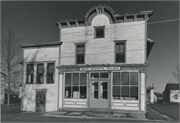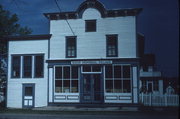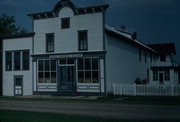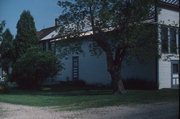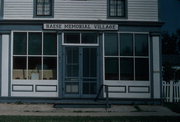| Additional Information: | A 'site file' exists for this property. It contains additional information such as correspondence, newspaper clippings, or historical information. It is a public record and may be viewed in person at the Wisconsin Historical Society, State Historic Preservation Office.
SEE NRHP SKETCH MAP,BRACKETED ROUND ARCH FALSE FRONT LIVING QUARTERS ATTACHED TRANSOM WINDOW OVER DOUBLE DOOR HARDWARE, PLUMBING AND LIGHTING FIXTURES FROM 1914
Forest Junction began as a crossing of two railroads in the lowland forests of northeastern Calumet County. Indeed, the village's storefronts faced the tracks. Among them was the Haese General Merchandise Store, now a museum. Built in 1884 by a local carpenter for John Otto, the building grew over the years as its subsequent owner, F. G. Haese, responded to changing circumstances. Haese added lumber and other building materials to his line of merchandise in 1893, when the national economic depression forced many of his customers in northern-Wisconsin lumber camps to pay for their goods in lumber instead of cash. And when the Automobile Age dawned, he opened a filling station. But the automobile proved to be his undoing. As cars brought increased mobility, customers began shopping in Appleton and other larger cities. Today, the Haese store reminds us of the way things were.
The building is remarkably intact. Its two-story facade rises above the height of the front-gabled building to form an imposing but false front. On the ground floor, pilasters frame a typical nineteenth-century storefront: a pair of glazed and paneled double-doors with a two-light transom above, and on either side, three-over-three display windows over paneled kickplates. Above this storefront, a bracketed parapet wall with a semicircular pediment crowns the clapboard second-story. The small attic window below the parapet was added in 1914, but the rectangular sash windows are original. Inside the store, the original furnishings include light fixtures, a wood-stove, wooden counters, and built-in cabinets. Haese's living quarters were in the back.
The Haese General Merchandise Store is part of a complex of buildings, representing Haese's family life and his business interests. An annex with a shorter profile is attached to one side. Adjacent to the store is the frame shed that served as a filling station, along with a milkhouse and summer kitchen, a carriage house and granary, a smokehouse, and an outhouse. Across Randolf Street is Haese’s barn, a hardware store and warehouse that he acquired in 1889, and a machine shed, built in 1914, where he displayed his farm implements. |
|---|

